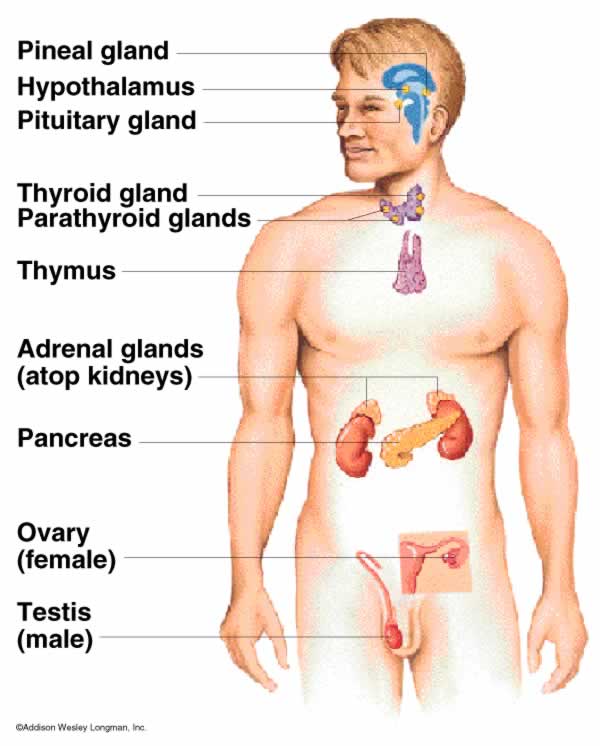Endocrine System
Hormone Production
The endocrine system is composed of glands which secrete chemicals called hormones directly into the bloodstream. The blood carries the hormone to a target organ where it produces an effect. Compared to the nervous system the effects are slower but act for longer.
The pituitary gland in the brain is a ‘master gland’ which secretes several hormones into the blood in response to body conditions. These hormones in turn act on other glands to stimulate other hormones to be released to bring about effects.
Hormone Transporation
- ADH, LH, FSH, gonad stimulating hormone, thyroid-stimulating hormone and growth hormones are produced by the pituitary gland. The pituitary gland secretes hormones which then lead to other secreting hormones.
- Insulin and glucagon are produced by the pancreas to regulate sugar levels.
- Oestrogen is produced by the ovaries. It is needed to repair the womb lining, and it promotes the development of female secondary sexual characteristics such as extra hair, change in boy and the production of eggs during the menstrual cycle.
- Testosterone is produced by the testes. It is needed to promote male secondary sexual characteristics such as the growth of hair and sperm production.
- Adrenalin is produced by the adrenal gland. It is released when we feel scared, and it would start out flight or fight reaction.
- Thyroxin is produced by the thyroid gland, and it controls our metabolism.
Insulin
Insulin is a hormone that is released from the pancreas, and it controls the blood glucose concentration. When the blood glucose concentration is too high, the pancreas releases insulin into the bloodstream so that it can reach muscles and liver tissues. Insulin will signal to the cells so that it can absorb the sugar from the bloodstream. Insulin allows the sugar to enter the cell so that energy can be created. If there is too much glucose, it is then converted into a storage carbohydrate called glycogen. However if the blood glucose concentration is too low, the pancreas will release another type of hormone called glucagon. Glucagon causes glycogen to be converted into glucose so that the concentration of glucose can be higher in the bloodstream.
Type 1Diabetes
Type 1 Diabetes is when the pancreas cannot produce enough insulin. As a result, when someone with type 1 diabetes has a meal, their blood sugar level rises. By controlling the individual’s diet, monitoring their blood sugar level and injecting insulin, they are able to use the sugar for energy.
Type 2Diabetes
Type 2 diabetes is when the liver cells produce insulin, but the body does not respond to it. It can be treated through a change in diet (control the carbohydrate intake) and exercise regime.
Water Nitrogen Balance
Osmoregulation controls the water levels and mineral ions in the blood. It is vital to control the water level and the mineral ions - it has to be the same concentration inside and around the cell. This will protect the cell from having too much or too little water.
The hypothalamus is a part of the brain that is continuously measuring the water potential of blood. If the concentration of water is a lot higher on the outside than the concentration of the concentration of water on the inside, water that tries to enter the cell may burst. However if the water concentration is a low lower outside in comparison to the inside, water may leave the cell, causing the cell to shrivel.
- Water leaves the body via the lungs during exhalation.
- Water, ions and urea are lost from the skin in sweat.
- There is no control over water, ion or urea loss by the lungs or skin.
- Excess water, ions and urea are removed via the kidneys in the urine.
- If body cells lose or gain too much water by osmosis they do not function efficiently.
- Which organ removes excess water, ions and urea?
- Kidney
- What happens if too much water tries to enter the cell through osmosis?
- Your answer should include: Cell / Burst
- What is the treatment for type 2 diabetes?
- Your answer should include: Change / Diet / Exercise / Regime
